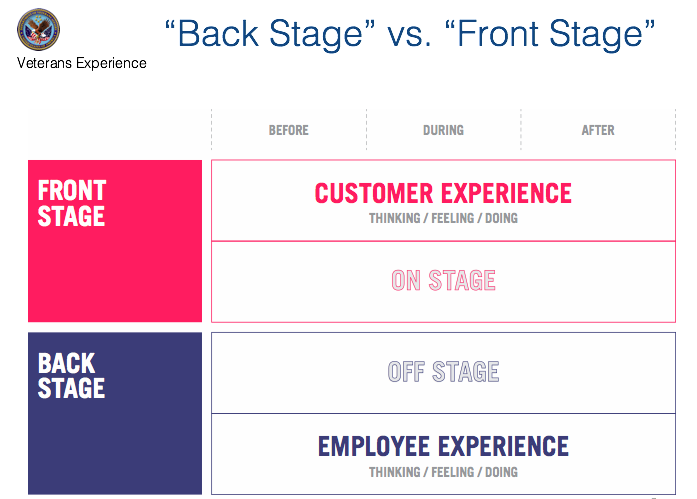CXDC 2016 Q&A with The Department of Veterans Affairs (VA)
CXDC 2016 is just around the corner, and we have an incredible agenda featuring 25+ Federal CX leaders and top Forrester analysts.
I asked two of our speakers from the Department of Veterans Affairs (VA) – Sarah Brooks, Director, Insight & Design and Julia Kim, Chief of Staff, Veterans Experience – to chat about some of the ways VA is improving the customer experience (CX) for veterans.
Rick: The CX team at VA has been very busy! What two or three CX improvements over the past year are you most proud of? Why?
Sarah and Julia: It has been busy! Especially when we are trying to build the office while also doing the work. We are proud of many things (more than we can put into a blog post!), but here are a few things we’ll highlight:
- Reframing the Disability Compensation and Pension application process from Veterans’ points of view. There were only five people in our office, and Secretary Bob asked us to look into this thing that he was getting a lot of calls and emails about. What we found is that VA is not managing our Veteran-facing touchpoints during this process – in fact, we have very few front stage touchpoints at all. We have done a lot of work to optimize the back stage (see figure 1). We were not thinking about how to help Veterans understand what was happening and why it was happening. This was our first exposure to what has become a recurring theme at VA.

- Creating a Veterans’ life journey map. We created the first ever journey map for Veterans told from their point of view (see figure 2). It captures Veterans’ lives and maps VA onto that – not vice versa. It comes from a ton of research on the road, talking to Veterans in their homes, offices, and at VA. Whenever we show it to Veterans, they recognize themselves in it. They point to the spot on the journey where they currently are and where their friends are. What is also exciting is that people who work with Veterans – our colleagues at VA and also people and groups outside VA – immediately “get it” and can see why they would look at things this way. We even heard from a Congressional staffer who got a copy and wanted to know how they could approach developing legislation differently using the journey map.

- Improving our communications with Veterans about VA. We are working with VA’s product and service teams to rewrite all the letters that VA sends. Literally, all the letters – everything from telling people when their medical appointments are (we use VA “codes” to tell people which clinic to report to!) to an explanation of their disability compensation (see above!). Our processes, like many government processes, are difficult to engage with and can seem like a black box. In the absence of relevant information, people assume bad intent. VA’s letters need to be written and designed for Veterans: a clear, thorough explanation of what they need to do; a realistic promise of what we will do and what they can expect. This is how we build trusted relationships with those we serve. In addition to rewriting the letters, we are also developing a VA Welcome Kit and Quick Start Guides. They will help people understand how to get started accessing VA. We are organizing and aggregating the content around Veterans’ lives and needs (healthcare, job and education, housing, and financial help) not VA’s org chart and “program offices.” This is a huge shift.
Rick: How important is a customer-centric culture to VA's CX success?
Julia and Sarah: The Secretary has set as a goal to be the #1 customer service agency in the federal government. Being customer-centric and putting Veterans first is the foundational principle of this effort – it has to infuse everything we do in VA, along with being guided by our values. What Veterans think and feel is our truth. Operational measures do not replace hearing directly from those we serve. So we are continually out in the field talking to Veterans, listening to them, understanding whether our intentions translate to how they perceive their interactions with us, what builds trust and what frays it. This is the beginning of developing the outside-in perspective that is the default in much of the private sector.
Rick: So many people want to help VA improve its CX. It seems like you could end up with too many cooks in the kitchen. How do you coordinate and lead such a diverse group with so many ideas?
Sarah and Julia: We see one of the roles of our office as “steward.” We are interested in understanding the needs and goals of Veterans, Congress, the Press, VSOs [Veteran Service Officers] and the full ecosystem of non-profits that support VA. It is a lot of data to make sense of, but we use the best practices from the private sector which can handle this level of complexity. VA has to serve all Veterans who are eligible for benefits. Our North Star is what we learn from Veterans. This is the lens through which we filter everyone else’s input.
We are working on a lot of things all at the same time. And at all different scales. We are working on helping the senior leader team, the frontlines, and within VA offices. Given that we’re only 18 months old, this feels like the right way to be operating. We’re nimble and adaptive to emerging conditions. We have to be.
Like what you hear? Join us on September 12 at the W Washington to learn more from Julia, Sarah and other incredible federal CX leaders. Register now and take advantage of our $100 discount code using CXDCWEB. And don’t forget to use #FORRCXDC to share this event with others who want to improve the federal customer experience. Hope to see you at CXDC!
